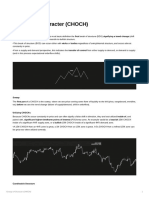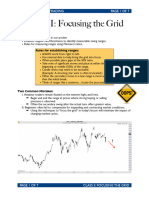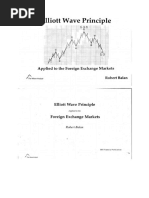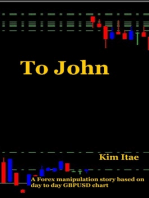Understanding Higher and Lower Timeframe Analysis
Uploaded by
Andy KwartengUnderstanding Higher and Lower Timeframe Analysis
Uploaded by
Andy Kwarteng### Understanding Higher and Lower Timeframe Analysis
When using multiple timeframes in trading, it is essential to understand the
interaction between higher and lower timeframes. The higher timeframe gives you the
overall market trend, while the lower timeframe provides more precise entry and
exit points.
### Scenarios with Higher and Lower Timeframes
1. **Higher Timeframe (1-Hour) is Bearish, Lower Timeframe (5-Minute) is Bullish**:
- **Primary Action**: Avoid taking long positions. Instead, look for shorting
opportunities.
- **Reason**: The overall trend is bearish, so it's generally safer to trade in
the direction of the higher timeframe trend.
2. **Higher Timeframe (1-Hour) is Bullish, Lower Timeframe (5-Minute) is Bearish**:
- **Primary Action**: Avoid taking short positions. Instead, look for buying
opportunities.
- **Reason**: The overall trend is bullish, so it's generally safer to trade in
the direction of the higher timeframe trend.
### Steps to Approach Trades Based on Timeframe Analysis
1. **Determine the Overall Trend**:
- Use the higher timeframe (e.g., 1-hour chart) to identify the overall trend
direction using the Ichimoku Cloud.
- If the price is below the Kumo, the trend is bearish.
- If the price is above the Kumo, the trend is bullish.
2. **Check the Lower Timeframe**:
- Use the lower timeframe (e.g., 5-minute chart) to find entry and exit points.
- Align trades with the higher timeframe trend.
### Practical Strategies
#### When Higher Timeframe is Bearish and Lower Timeframe is Bullish
1. **Wait for Lower Timeframe Alignment**:
- Do not take long positions even if the lower timeframe is showing bullish
signals.
- Wait for the lower timeframe to align with the higher timeframe trend (i.e.,
wait for bearish signals on the lower timeframe).
2. **Look for Reversal Patterns**:
- On the lower timeframe, look for signs of trend reversals (e.g., bearish
engulfing patterns, Kumo breakouts to the downside).
- Use these reversal patterns to time your entry for short positions.
3. **Use Ichimoku Filters**:
- Ensure that the Tenkan-sen is below the Kijun-sen and that the Chikou Span is
below the price for bearish confirmation on the lower timeframe.
#### When Higher Timeframe is Bullish and Lower Timeframe is Bearish
1. **Wait for Lower Timeframe Alignment**:
- Do not take short positions even if the lower timeframe is showing bearish
signals.
- Wait for the lower timeframe to align with the higher timeframe trend (i.e.,
wait for bullish signals on the lower timeframe).
2. **Look for Reversal Patterns**:
- On the lower timeframe, look for signs of trend reversals (e.g., bullish
engulfing patterns, Kumo breakouts to the upside).
- Use these reversal patterns to time your entry for long positions.
3. **Use Ichimoku Filters**:
- Ensure that the Tenkan-sen is above the Kijun-sen and that the Chikou Span is
above the price for bullish confirmation on the lower timeframe.
### Additional Considerations
1. **Avoid Overtrading**:
- Stick to your trading plan and avoid taking trades that go against the higher
timeframe trend.
2. **Risk Management**:
- Always use proper risk management techniques, such as setting stop-losses and
calculating position sizes based on your risk tolerance.
3. **Patience**:
- Be patient and wait for the lower timeframe to align with the higher timeframe
trend. This can increase the probability of successful trades.
### Example of Timeframe Analysis
#### Scenario: Higher Timeframe (1-Hour) is Bullish
1. **1-Hour Chart**:
- Price is above the Kumo.
- Overall trend is bullish.
2. **5-Minute Chart**:
- Look for price action to align with the bullish trend.
- Wait for a bullish Kumo breakout or a bullish reversal pattern on the 5-minute
chart.
3. **Entry**:
- Enter long positions when the 5-minute chart shows bullish confirmation.
4. **Exit**:
- Use trailing stops or predefined profit targets to exit trades.
By aligning your trades with the overall trend direction of the higher timeframe
and using the lower timeframe for precise entries and exits, you can increase the
likelihood of profitable trades. This approach helps you to filter out less
reliable trades and stay in sync with the dominant market trend.
You might also like
- Module 6 - Elliot Wave and Wavy Tunnel ConnectionNo ratings yetModule 6 - Elliot Wave and Wavy Tunnel Connection33 pages
- A Complete Guide To Volume Price Analysis Read The Book Then Read The Market by Anna Coulling (Z-Lib - Org) (061-120)No ratings yetA Complete Guide To Volume Price Analysis Read The Book Then Read The Market by Anna Coulling (Z-Lib - Org) (061-120)60 pages
- How To Use Balance Zones To Trade in 5 Easy Steps100% (1)How To Use Balance Zones To Trade in 5 Easy Steps6 pages
- Top 10 Strategies For Profit On Binary Options80% (10)Top 10 Strategies For Profit On Binary Options26 pages
- Divergence Cheat Sheet: Bias Price Oscillator Description Sample ChartsNo ratings yetDivergence Cheat Sheet: Bias Price Oscillator Description Sample Charts2 pages
- The 3 Principle Method of Trading BlueprintNo ratings yetThe 3 Principle Method of Trading Blueprint15 pages
- Multiple Timeframe Analysis For Intraday TradingNo ratings yetMultiple Timeframe Analysis For Intraday Trading9 pages
- 01.best Notes and Strategies To RememberNo ratings yet01.best Notes and Strategies To Remember31 pages
- Scalping Trading Course - Option Scalping - ElearnmarketsNo ratings yetScalping Trading Course - Option Scalping - Elearnmarkets11 pages
- Swing Trade Manual Professional Guide 13No ratings yetSwing Trade Manual Professional Guide 1315 pages
- Wiley - Trading The Elliott Waves - Winning Strategies For Timing Entry and Exit Moves - 978-1-118-63291-8No ratings yetWiley - Trading The Elliott Waves - Winning Strategies For Timing Entry and Exit Moves - 978-1-118-63291-82 pages
- The MA Breakout Based On ICI and Momentum in FX-2No ratings yetThe MA Breakout Based On ICI and Momentum in FX-228 pages
- Dotnettutorials.net-Opening Range BreakoutNo ratings yetDotnettutorials.net-Opening Range Breakout17 pages
- Alan Farley-Targeting Profitable Entry & Exit Points PDFNo ratings yetAlan Farley-Targeting Profitable Entry & Exit Points PDF29 pages
- Stochastic Oscillator (HowToTrade Cheat Sheet)No ratings yetStochastic Oscillator (HowToTrade Cheat Sheet)3 pages
- The Profitability of Momentum StrategiesNo ratings yetThe Profitability of Momentum Strategies15 pages
- dotnettutorials.net-Trading with Sideways Price Action AreaNo ratings yetdotnettutorials.net-Trading with Sideways Price Action Area7 pages
- Chart Analysis - Introduction To Wave Analysis v2.0No ratings yetChart Analysis - Introduction To Wave Analysis v2.048 pages
- Agrawal Technical Analysis Gurukul: First Learn Than Earn .No ratings yetAgrawal Technical Analysis Gurukul: First Learn Than Earn .6 pages
- SPB-Bootcamp-Getting-Started-with-Secrets-of-a-Pivot-BossNo ratings yetSPB-Bootcamp-Getting-Started-with-Secrets-of-a-Pivot-Boss21 pages
- Introduction To Donchian Channels ReportNo ratings yetIntroduction To Donchian Channels Report6 pages
- 04 - Trading Strategy - Trend ContinuationNo ratings yet04 - Trading Strategy - Trend Continuation2 pages
- Wave Conditions Implications Fibonacci: Point Zero100% (1)Wave Conditions Implications Fibonacci: Point Zero4 pages
- Day Trading Guide From A To Z: Successfully & Profitably Trading Strategies To Maximize Your Profits: (Workbook & Powerful Forex Trading System For Average 2000+ Pips Every Month To Your MT4 Account)From EverandDay Trading Guide From A To Z: Successfully & Profitably Trading Strategies To Maximize Your Profits: (Workbook & Powerful Forex Trading System For Average 2000+ Pips Every Month To Your MT4 Account)No ratings yet
- Market Cycle Timing and Forecast 2016 2017 PDFNo ratings yetMarket Cycle Timing and Forecast 2016 2017 PDF22 pages
- A Study On Fundamental and Technical Analysis of StocksNo ratings yetA Study On Fundamental and Technical Analysis of Stocks71 pages
- Understanding Momentum in Investment Technical AnalysisNo ratings yetUnderstanding Momentum in Investment Technical Analysis148 pages
- Bearish Engulfing Pattern Trading Strategy Guide100% (2)Bearish Engulfing Pattern Trading Strategy Guide17 pages
- Strategy Trader::: Onsen Cumulative Delta DivergenceNo ratings yetStrategy Trader::: Onsen Cumulative Delta Divergence11 pages
- Derivatives: Types of Derivative ContractsNo ratings yetDerivatives: Types of Derivative Contracts20 pages
- Adam Khoo's Golden Investment PrinciplesNo ratings yetAdam Khoo's Golden Investment Principles2 pages
- Ferrera's 2012 Stock Market Forecast Now Available: 2011 Forecast Nailed May TopNo ratings yetFerrera's 2012 Stock Market Forecast Now Available: 2011 Forecast Nailed May Top2 pages
























































































